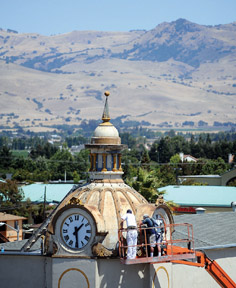The U.S. Census Bureau performs the decennial (10-year) census as required by the U.S. Constitution. Among the information, they collect data related to population, ethnicity and race. The following basic data comes directly from the census or census based demographic reports.
For obvious historical reasons California has always had a significant Hispanic population, typically among the top three states. In 1990, Hispanics accounted for 26% of the state residents, by 2010 that had risen to 38%. For several decades, at least, Hollister has had a Hispanic majority and significantly larger Hispanic population portion than the state as a whole.
An analysis of Hollister’s population ethnic data shows that the local Hispanic population has grown mirroring changes throughout the state; however, the local non-Hispanic population has shrunk significantly for no apparent reason while the state’s data stayed level. State growth of the Hispanic population from 2000 to 2010 was 28%; state growth of the non-Hispanic population during that period was 1.5%.
From 1990 to 2000, the City of Hollister experienced considerable growth. The population grew by 15,195 or 79% from 19,216 to 34,413. During that period, the local ethnic makeup stayed essentially stable. In 1990, the Hispanic population made up 55% of the city residents and the non-Hispanic population made up 45%; 10 years later in 2000, the ratio was almost identical, 55.1% Hispanic and 44.9% non-Hispanic.
There was some minor shifting within the non-Hispanic groups during that period. In 1990, the non-Hispanic group was overwhelmingly White, 91%, but that dropped slightly to 86% by 2000. In the next decade, from 2000 to 2010, Hollister’s total population was stagnant, increasing only 515 to 34,928, or 1.5%. However, there was a significant shift in the ethnicity of the city residents.
Hollister’s Hispanic population increased 4,016 or 21% while the non-Hispanic population fell by 3,501 or 23%. The result was that the overall Hispanic portion increased from 55% to 66% while the non-Hispanic portion fell from 45% to 34%. The largest count drop was among the non-Hispanic White group that fell 3,083 from 13,246 to 10,163 or 23%. The other non-Hispanic groups dropped a total of 387 persons or 19%.
The City of Hollister should perform a review to determine the cause of the substantial loss in non-Hispanic population that is so different from the state’s experience. The purpose would be to ascertain whether the shift was the result of normal causes, unusual circumstances or local economic factors.
There may be good explanations for this shift such as changes in self-identification and/or increases in inter-ethnic marriages with the associated name changes, age differentials, or specific groups seeking opportunities elsewhere. It has even been suggested that foreclosures during the housing crisis disproportionally affected young non-Hispanic because they made up a majority of the at-risk homeowners forced to relocate; whatever it is, we need to know the answer.
Just imagine the reaction if the figures were reversed and there was an unexplained 23% drop in the Hispanic population in only a decade; it would certainly raise questions. Some of the six other non-Hispanic categories also had high population loss rates. The Black population fell 130, or 30%, while the “other race” category fell 161, or 76%. For small populations a minor count change can result in a large percentage shift.
We need to know what caused this shift and whether it is indicative of our aging non-Hispanic population, local economic problems or something else.










